Magicicada septendecim cicada from Brood IX in Greenbrier County, WV. Photo by Tony Maro. Thanks Tony!
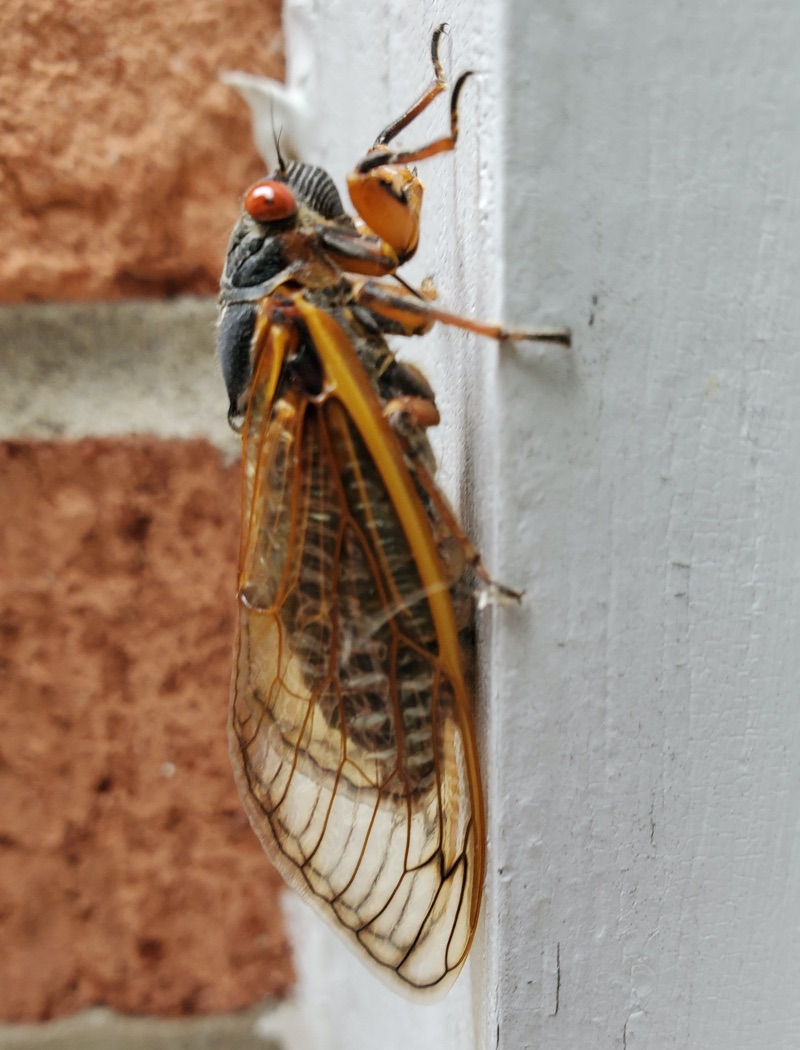
Genera of cicadas.
Magicicada septendecim cicada from Brood IX in Greenbrier County, WV. Photo by Tony Maro. Thanks Tony!

Skip to a section: Broods | Your Town | Pre Emergence Signs | Compare Magicicada Species.
The Forecast for 2025 is Brood XIV will emerge in Georgia, Indiana, Kentucky, Massachusetts, North Carolina, New York, Ohio, Pennsylvania, Tennessee, Virginia, and West Virginia. (Green means the emergence has begun.) Looks like New Jersey is a bust. 🙁
Stragglers from other broods have been reported.
The Brood Chart features the names of the broods (Roman numerals), emergence years, cycle-length, straggler-years, species and states where they may emerge.
| Brood | Year | Cycle | States |
|---|---|---|---|
| I | 2029 | 17 | TN, VA, WV |
| II | 2030 | 17 | CT, GA, MD, NC, NJ, NY, OK, PA, VA |
| III | 2031 | 17 | IA, IL, MO |
| IV | 2032 | 17 | IA, KS, MO, NE, OK, TX |
| V | 2033 | 17 | LI NY, MD, OH, PA, VA, WV |
| VI | 2034 | 17 | GA, NC, SC, WI, OH |
| VII | 2035 | 17 | NY |
| VIII | 2036 | 17 | OH, PA, WV, OK |
| IX | 2037 | 17 | NC, VA, WV |
| X | 2038 | 17 | DE, GA, IL, IN, KY, MD, MI, NC, NJ, NY, OH, PA, TN, VA, WV, DC |
| XIII | 2041 | 17 | IA, IL, IN, MI, WI |
| XIV | 2025 | 17 | GA, IN, KY, MA, NC, |
| XIX | 2037 | 13 | AL, AR, GA, IA, IL, IN, KY, LA, MD, MO, MS, NC, OK, SC, TN, VA |
| XXII | 2027 | 13 | KY, LA, MS, OH |
| XXIII | 2028 | 13 | AR, IL, IN, KY, LA, MO, MS, TN |
Emergences: 2029, 2012, 1995, 1978, 1961.
Cycle: 17-Year.
Stragglers: 2025 (-4), 2028 (-1).
Species: M. septendecim, M. cassini, M. septendecula.
States: TN, VA, WV
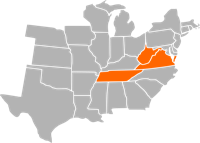
Emergences: 2030, 2013, 1996, 1979, 1962.
Cycle: 17-Year.
Stragglers: 2026 (-4), 2029 (-1)
Species: M. septendecim, M. cassini, M. septendecula.
States: CT, GA, MD, NC, NJ, NY, OK, PA, VA
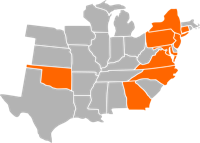
Emergences: 2031, 2014, 1997, 1980, 1963.
Cycle: 17-Year.
Stragglers: 2027 (-4), 2030 (-1)
Species: M. septendecim, M. cassini, M. septendecula.
States: IA, IL, MO
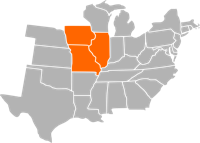
Emergences: 2032, 2015, 1998, 1981, 1964.
Cycle: 17-Year.
Stragglers: 2028 (-4), 2031 (-1)
Species: M. septendecim, M. cassini, M. septendecula.
States: IA, KS, MO, NE, OK, TX
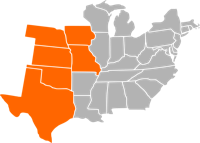
Emergences: 2033, 2016, 1999, 1982, 1965.
Cycle: 17-Year.
Stragglers: 2029 (-4), 2032 (-1)
Species: M. septendecim, M. cassini, M. septendecula.
States: LI NY, MD, OH, PA, VA, WV
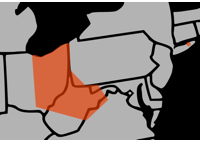
Emergences: 2034, 2017, 2000, 1983, 1966.
Cycle: 17-Year.
Stragglers: 2030 (-4), 2933 (-1)
Species: M. septendecim, M. septendecula.
States: GA, NC, SC, WI, OH
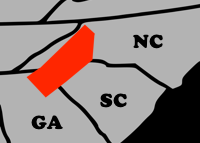
Emergences: 2035, 2018, 2001, 1984, 1967.
Cycle: 17-Year.
Stragglers: 2031 (-4), 2034 (-1)
Species: M. septendecim.
States: NY
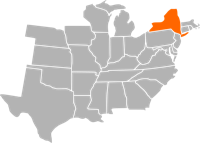
Emergences: 2036, 2019, 2002, 1985, 1968.
Cycle: 17-Year.
Stragglers: 2032(-4), 2035(-1)
Species: M. septendecim, M. cassini, M. septendecula.
States: OH, PA, WV and OK
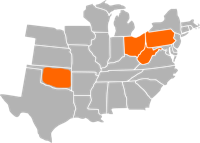
Emergences: 2037, 2020, 2003, 1986, 1969.
Cycle: 17-Year.
Stragglers: 2033(-4), 2036(-1)
Species: M. septendecim, M. cassini, M. septendecula.
States: NC, VA, WV
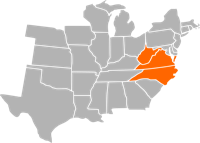
Emergences: 2038, 2021, 2004, 1987, 1970.
Cycle: 17-Year.
Stragglers: 2034(-4), 2037(-1)
Species: M. septendecim, M. cassini, M. septendecula.
States: DE, GA, IL, IN, KY, MD, MI, NC, NJ, NY, OH, PA, TN, VA, WV, DC
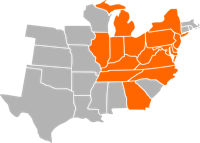
Emergences: 2041, 2024, 2007, 1990, 1973.
Cycle: 17-Year.
Stragglers: 2025(+1)
Species: M. septendecim, M. cassini, M. septendecula.
States: IA, IL, IN, MI, WI
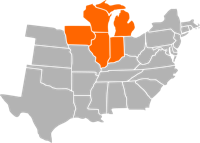
Emergences: 2025, 2025, 2008, 1991, 1974, 1957.
Cycle: 17-Year.
Stragglers: 2026(+1)
Species: M. septendecim, M. cassini, M. septendecula.
States: GA, IN, KY, MA, NC, NY, OH, PA, TN, VA, WV
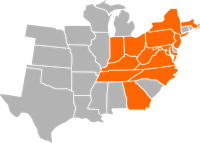
Emergences: 2037, 2024, 2011, 1998, 1985.
Cycle: 13-Year.
Stragglers: 2025(+1), 2028(+4)
Species: M. tredecim, M. neotredecim, M. tredecassini, M. tredecula.
States: AL, AR, GA, IA, IL, IN, KY, LA, MD, MO, MS, NC, OK, SC, TN, VA
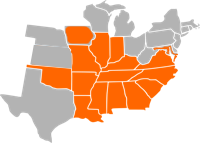
Emergences: 2027, 2014, 2001, 1988, 1975.
Cycle: 13-Year.
Stragglers: 2026(-1), 2032(+4)
Species: M. tredecim, M. tredecassini, M. tredecula.
States: KY, LA, MS, OH
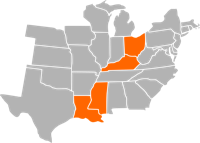
Emergences: 2028, 2015, 2002, 1989, 1976.
Cycle: 13-Year.
Stragglers: 2027(-1), 2032(+4)
Species: M. tredecim, M. neotredecim, M. tredecassini, M. tredecula.
States: AR, IL, IN, KY, LA, MO, MS, TN
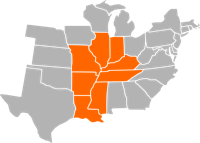
Here is a map of all Broods from the Cicadas @ UCONN site. Zoom in and click the pins to see which Brood it represents. (May not work on older devices.)
Generally speaking, these cicadas will begin to emerge when the soil 8″ beneath the ground reaches 64 degrees Fahrenheit (Heath, 1968). A nice, warm rain will often trigger an emergence. They can emerge anytime from early April to early June. It all depends on the weather.
Look for cicada chimneys a.k.a. turrets. These are structures cicadas build out of the soil, positioned above the hole where they will emerge.
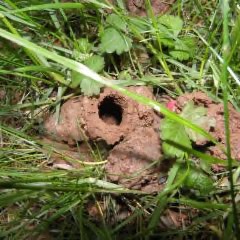
Look for holes in the diameter of an adult’s finger near the root system of a tree. These are sure signs that cicadas will emerge in the area.
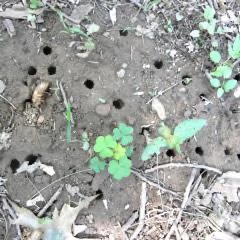
You might discover some cicada nymphs while turning over stones or when performing landscaping chores.
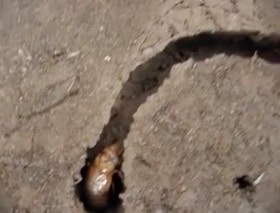
Here is a great video of Magicicada nymphs once they have emerged from the ground:
This is a recently emerged nymph crawling up a tree. Note that its eyes are red.
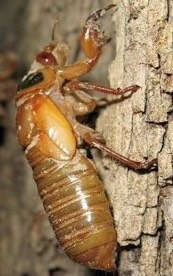
Once cicadas nymphs have emerged from the ground, they will try to find a tree (or similar vertical surface), and then begin the process of shedding their old nymph skins (ecdysis), expanding their wings, and changing to their adult coloring. Watch this amazing transformation.
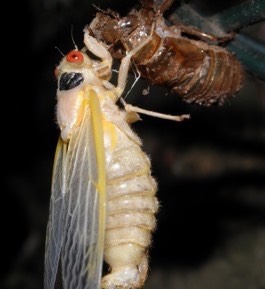
Left to right: Magicicada cassini, Magicicada septendecula, Magicicada septendecim:
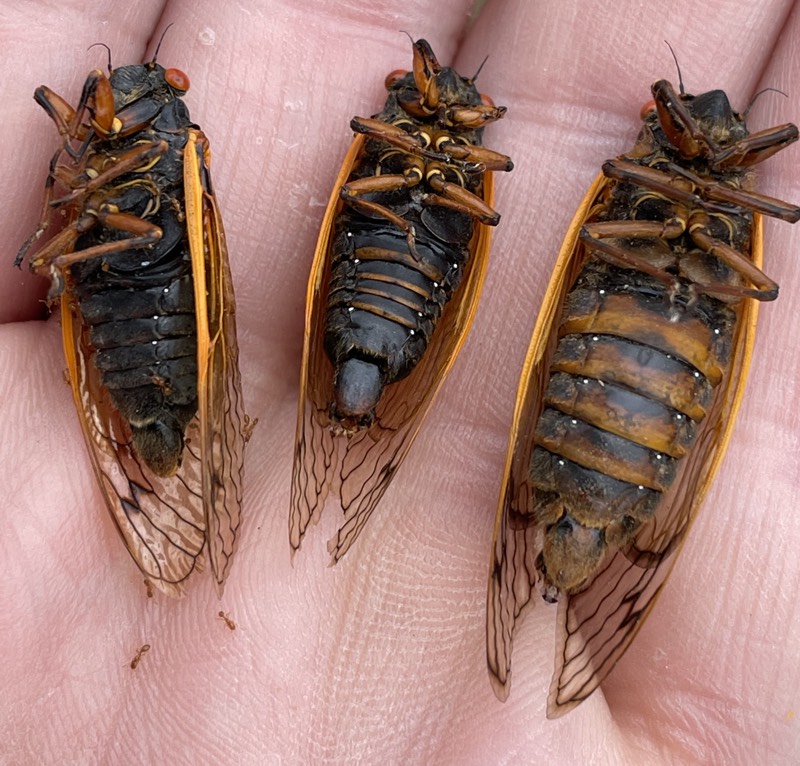
The first way is based on the Brood. Take a look at the Brood chart above, and see which species appear with the Brood.
There are 3 basic types of Magicicada: “‘Decims”, “‘Cassini” and “‘Deculas”.
There are three species in this category:
Their songs are very similar, however, when M. neotredecim & M. tredecim emerge in the same location, M. neotredecim’s song takes a higher pitch. Sounds like “Pharaoh, Pharaoh!”.
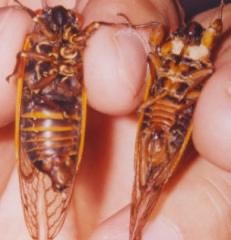
Male on left; Female on right.
M. neotredecim & M. septendecim have broad orange stripes with more orange than black on their abdomens.
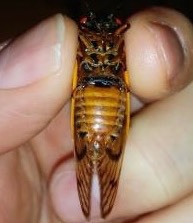
M. tredecim, by comparison, have almost entirely orange abdomens.
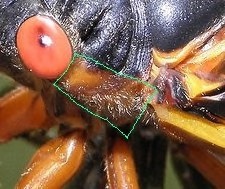
M. septendecim cicadas also have an area of orange coloring between the eye and the wing (pronotal extension).
There are two species in this category:
Their songs are essentially identical:
Note how it makes a quick burst of sound, followed by some rapid clicks.
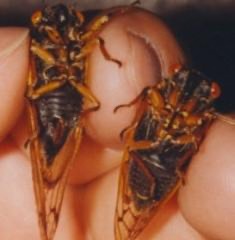
Female on left; Male on right.
M. tredecassin & M. cassini cicadas have black abdomens with virtually no orange at all. Orange stripes are possible in the mid-west (important to note for Brood IV).
There are two species in this category:
Their songs are essentially identical:
Note the “tick, tick, tick” rhythm of the call.
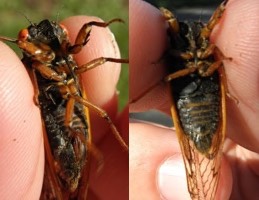
Female on left; Male on right.
M. septendecula & M. tredecula have stripes that feature more black than orange. Otherwise, they’re very similar to M. cassini.
Question: Why do I have cicadas in my neighborhood, but your chart indicates that I shouldn’t?
Answer: Some possibilities: 1) they are stragglers, periodical cicadas that emerge too soon or late, 2) they are not periodical cicadas but are a different North American species, 3) you live on a continent other than North America, in which case, try one of these pages, or 4) SURPRISE! The U.S. is a big place and some cicada populations have yet to be documented.
Question: Why don’t I have periodical cicadas in my area, but the information on your website indicates that I should?
Answer: Two possibilities: 1) they went extinct or otherwise died off in your area, or 2) they aren’t everywhere in a state – normally there are large gaps in their range.
Question: What are stragglers?
Answer: Stragglers can emerge 1 or 4 years early or 1 or 4 years late. Don’t be surprised if you see some periodical cicadas emerge earlier than planned this year. 17-year brood members are most likely to straggle 4 years early, and 13-year brood members are most likely to straggle 4 years late. Straggler probability chart.
Question: Are there other types of Periodical cicadas?
Answer: There are two known species of periodical cicadas that are not Magicicada . One lives in India and the other in Fiji.
Question: Why are there no Brood XI, XII, XV, or XVI?
Answer: Perhaps you’ve noticed there are no Broods XI (11), XII (12), XV (15), XVI (16), XVII (17), XVIII (18), XX (20), XXI (21), XXIV (24), etc. Don’t worry about that. They never existed or are extinct (XI, XXI).
Question: In total, how often do periodical cicadas emerge?
Answer: Over the next 10 years (including 2025), there’s a 90% chance at least one Magicicada brood will emerge somewhere in the U.S.A. Across time, that percentage falls to 77%. Next year (2026) no Broods will emerge. The next 3 year gap (max gap) is 2043-2045.
This is an example of a typical cicada emergence. The exact dates will depend on the weather and density of the emergence in your location. Hot weather means an early start and quicker finish to the season — cool weather means a later start and a protracted season.
Here’s an Excel version of the chart. Feel free to use it and adjust it to match your experience.
Or watch the video version:
Rebecca van den Bogert shared this photo of a cicada from Ecuador.
Details: “Plaza de Ponchos” Marktet in Otovalo / April 19th 2007 / 2 p.m. / about 65 °F.
I’m reasonably certain it belongs to the genus Pachypsaltria, and might be Pachypsaltria cinctomaculata. I’m not 100% of that.
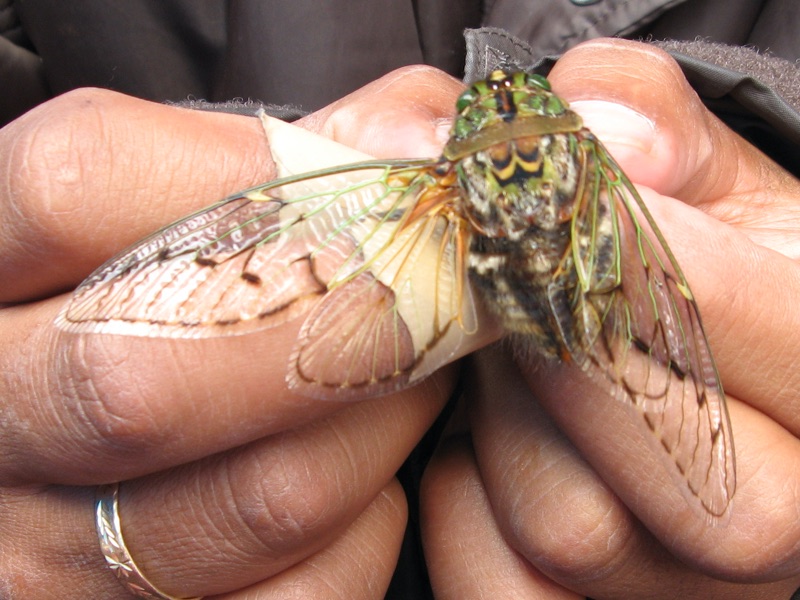
Photo by Rebecca van den Bogert. Original was cropped.
In 2020, the main periodical cicada brood expected to emerge in the U.S. is Brood IX (9). Brood IX will emerge in southern West Virginia, western Virginia, and a small portion of north-western North Carolina. This we know for sure.
If you want to see where cicadas are being reported, try the Cicada Safari App is available for Android and Apple devices .
OK, here’s the point of this article:
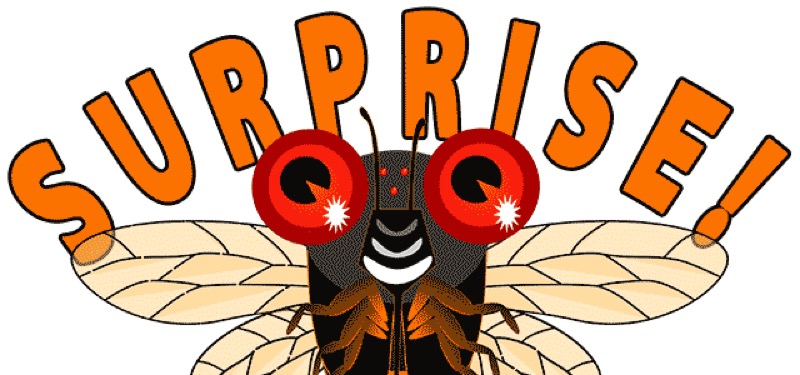
Cicadas from other broods will also emerge this year in small numbers. When cicadas emerge early or late, they’re called stragglers. Don’t get hung up on the meaning of the word. If it makes you happy, call the ones that emerge early “precursors”, “pioneers”, or “heralds”.
Members of Brood XIX (19) are emerging in parts of North Carolina and Georgia, where Brood XIX is know to exist. There’s some discussion of this over on the Cicada Discussion, Science and Study Group on Facebook. You might see them in Alabama, Arkansas, Georgia, Illinois, Indiana, Kansas, Kentucky, Lousiana, Missouri, Mississippi, North Carolina, Oklahoma, South Carolina, Tennessee, and Virginia.
The rest of Brood XIX will emerge in 2024. Here’s a map.
Here’s a paper that discusses 13-year Magicicada emerging 4 years early: David C. Marshall, Kathy B. R. Hill, and John R. Cooley “Multimodal Life-Cycle Variation in 13- and 17-Year Periodical Cicadas (Hemiptera: Cicadidae: Magicicada),” Journal of the Kansas Entomological Society 90(3), 211-226, (1 July 2017). https://doi.org/10.2317/0022-8567-90.3.211
Members of Brood XIII (13) are likely to emerge 4 years early in Iowa, Wisconsin, Illinois, Indiana, and possibly Michigan.
The rest of Brood XIII emerge in 2024 (a big year for periodical cicadas). Here’s a map.
Some members of Brood X (10) should emerge 1 year early in Delaware, Georgia, Illinois, Indiana, Kentucky, Maryland, Michigan, North Carolina, New Jersey, New York, Ohio, Pennsylvania, Tennessee, Virginia, West Virginia, and Washington D.C.
The rest of Brood X will emerge next year in 2021. Here’s a map.
Here’s a screen shot from the Cicada Safari app:
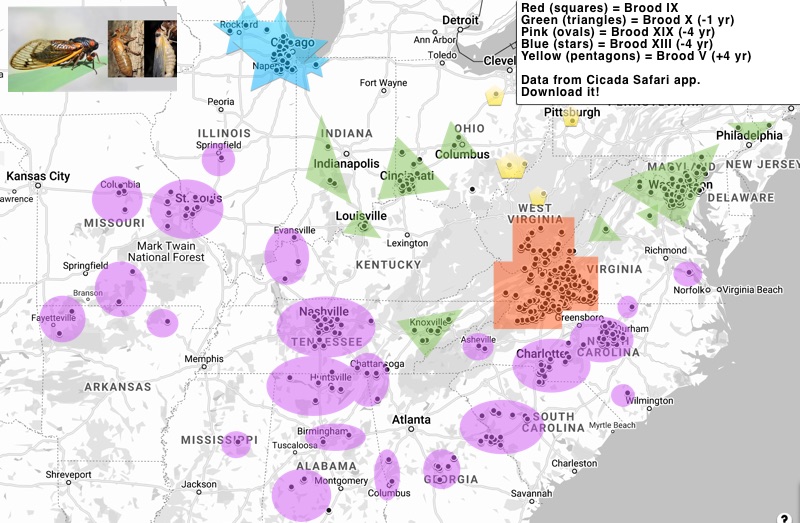
Within the app, you can zoom in to see where the cicadas are appearing. Here’s a “Live Map” of the sightings from the app.Pinch and zoom to get details.
Davis provided a key of cicadas that belong to the then genus Tibicen in his 1918 article Mississippi Cicadas, with a Key to the Species of the Southeastern United States from volume 26 of the Journal of The New York Entomological Society. Download it from archive.org. This guide works for the Northeast and Midwest as well.
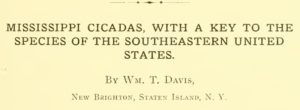
Since 1918, genus and some species names have changed, so I’m going to present the key here, with highlighted notes on the updated names + images (when I have them). I’ll try to replicate the formatting of the original document as best I can.
Here goes…
Note: the cicadas in the key are now organized in three genera: Neotibicen (A B), Megatibicen (A BB), and Diceroprocta (AA).
A. Large, heavy-bodied species; head broad, uncus [male genitals] simple, and first cross vein in the fore wings starting from radius 3 far back or about one-third distant from base of the first marginal cell.
B. Uncus longer than broad. Black species with green or greenish markings and black area on the central part of the abdomen beneath, except in sayi [sayi = Neotibicen tibicen tibicen], and new variety of davisi [new variety of davisi = Neotibicen davisi harnedi].
Note: this group of cicadas (B) are now organized under the genus Neotibicen, not Tibicen.
C. Hind margin of pronotum or collar, green or greenish.
A narrow irregular area of black on the under side of the abdomen; opercula short and broad, and usually in the males an attenuated, pruinose [frosty white] stripe each side on the dorsum of segment three … pruinosa (Say). [pruinosa = Neotibicen pruinosus pruinosus].
Dorsum of abdomen with the hind margin of the segments more or less brown and generally but a trace of pruinose stripe each side on segment three … pruinosa var. winnemanna (Davis) [pruinosa var. winnemanna = Neotibicen winnemanna].
[Generally speaking, east of the Appalachian mountains, you’ll find Neotibicen winnemanna, and west, it’s Neotibicen pruinosus.]
Dorsum of abdomen shining black with a broad pruinose mark each side on segment three; blackened area on under side of abdomen more in the nature of an even stripe … pruinosa var latifasciata (Davis) [pruinosa var. latifasciata = Neotibicen latifasciatus].
A longitudinal band of black on the under side of the abdomen, the opercula more lobate, and the margin of the front wings suddenly bent near the middle … linnei (Smith & Grossbeck) [linnei = Neotibicen linnei].
A definite longitudinal band of black on the under side of the abdomen; head with the front rather prominent. Not a large species … canicularis (Harris) [canicularis = Neotibicen canicularis].
An irregular band of black on the under side of the abdomen, head rounded in front; a rather small species … davisi (Smith & Grossbeck) [davisi = Neotibicen davisi davisi].
Abdomen greenish centrally on under side, blackened area wanting, marginal cells of fore wings clouded … davisi var. harnedi new variety [davisi var. harnedi = Neotibicen davisi harnedi].
CC. Hind margin of pronotum or collar black or nearly so (except in sayi var. australis).
D. Central area of the abdomen beneath black.
Opercula long and with the legs usually somewhat chest- nut colored ; the uncus when seen in profile forked, resembling the open mouth of a snake … similaris (Smith & Grossbeck) [similaris = Neotibicen similaris similaris].
Opercula much shorter, more rounded, and the black area on the under side of the abdomen in the nature of an even stripe. Uncus not forked … lyricen (De Geer) [lyricen = Neotibicen lyricen lyricen].
Blacker than typical lyricen, lacking the considerable amount of fulvous markings on the pronotum and mesonotum. A fulvous somewhat anchor-shaped mark centrally on the pronotum … lyricen var. engelhardti (Davis) [lyricen var. engelhardti = Neotibicen lyricen engelhardti].
DD. Central area of the abdomen not black beneath, often pruinose, as well as the long opercula.
Collar black, often with a greenish spot each side near the outer angles. … sayi (Smith & Grossbeck) [sayi = Neotibicen tibicen tibicen].
Collar all green or nearly so, as well as the pronotum and mesonotum … sayi var. australis (Davis) [sayi = Neotibicen tibicen australis].
BB. The uncus is broad at the base, triangular in shape, and generally about as broad as long. Opercula broad and rounded at the extremities no definite black area on the central part of the abdomen beneath, usually unicolorus.
Note: this group of cicadas (BB) are now organized under the genus Megatibicen, not Tibicen.
E. Wings long and narrow, collar 2 mm. or less in breadth at central portions ; dorsum of abdomen black or nearly so.
Basal cell of fore wings rusty in color, anal cells (membranes) of both pair of wings gray; usually expands 110 mm. or more … resonans (Walker) [resonans = Megatibicen resonans].
Basal cell of fore wings often black or nearly so, anal cells of both pair of wings yellowish. Expands about 100 mm … figurata (Walker) [figurata = Megatibicen figuratus].
EE. Wings broad, hind margin of the pronotum or collar green or greenish and more than 2 mm. broad.
F. Anal cells or membranes at base of fore and hind wings gray.
Dorsal segments of the abdomen not margined with brown ; in fresh specimens the basal segments pruinose, also the terminal segments, leaving the four middle segments black. A large species expanding over 110 mm. … grossus (Fabricius) [grossus = Megatibicen grossus].
FF. Anal cells or membranes at base of fore and hind wings light orange, two prominent marks on the mesonotum resembling the Hebrew letter resh inverted.
Fore wings with the first and second cross veins clouded, and the dorsum of the abdomen brownish or brownish black … resh (Haldeman) [resh = Megatibicen resh].
Fore wings with the first and second cross veins but faintly or not at all clouded and the abdominal segments margined posteriorly with brown. In fresh specimens there is usually a median row of white spots on the dorsum of the abdomen … marginalis (Walker) [marginalis = Megatibicen pronotalis walkeri].
AA. Small species; wings starting from about the middle of the first marginal cell.
Note: this group of cicadas (AA) are now organized under the genus Diceroprocta, not Tibicen.
G. First and second cross veins of fore wings clouded.
Expanse of wings about 90 mm … biconica (Walker) [biconica = Diceroprocta biconica].
Expanse of wings about 60 mm … olympusa (Walker) [olympusa = Diceroprocta olympusa].
GG. First and second cross veins of fore wings not clouded, wings clear throughout and expanding about 70 mm.
Head rather large, front rounded, collar greenish or yellowish and contrasted in color rather sharply with the brown and black of pronotum and mesonotum … viridifascia (Walker) [viridifascia = Diceroprocta viridifascia].
Head proportionately smaller than in the last ; front more pro- truding;- collar not so contrastingly colored and fore wings narrower … vitripennis (Say) [vitripennis = Diceroprocta vitripennis].
and that’s all folks…
Periodical cicada Brood IX (9) emerged in the spring of 2020 in North Carolina, Virginia and West Virginia. The last time this brood emerged was in 2003. It will emerge again in 2037.
Researchers need your help! If you see a cicada, please report it using the Cicada Safari App , available for Android and Apple phones.
Brood IX is interesting to researchers because it’s located very close to 5 other broods. In a normal year, researchers would be able to drive the roads of the area and map the location of the brood so we can get data as to where the broods intersect, but because of the current situation in the U.S., most if not all researchers will be able to travel — so we need you to let us know where they’re at. Read more on Cicadas @ UCONN (formerly Magicicada.org).
What, when, where, and why:
What:
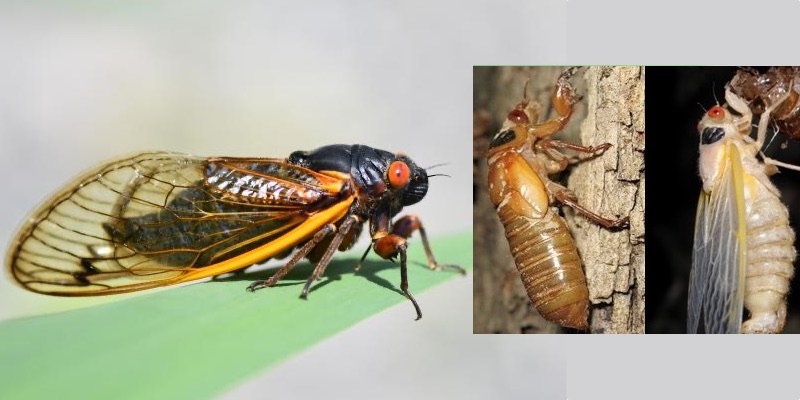
When: Typically beginning in mid-May and ending in late June. These cicadas will begin to emerge approximately when the soil 8" beneath the ground reaches 64 degrees Fahrenheit (Heath, 1968). A nice, warm rain will often trigger an emergence.
Other tips: these cicadas will emerge after the trees have grown leaves, and, by my own observation, around the same time Iris flowers bloom.
Where:
A quick tip using data from the Cicada Safari app team:
Cicadas in the north-west areas are Brood IX (red). Cicadas south & east of that area (purple) are Brood XIX emerging early.

Maps, Apps, and Tips:
Why: Why do they stay underground for 17-years? The prevailing research suggests they’ve evolved a long, 17-year lifecycle to avoid predators that can sync up with their lifecycle & emergence. Why are there so many?! Research suggests that their huge numbers allow them to overwhelm predators, so enough of them will live on to breed and perpetuate the brood.
More facts and fun:
The larger dots are valid. Tiny dots, no. See a modern map, or the Live Map from the Cicada Safari app.
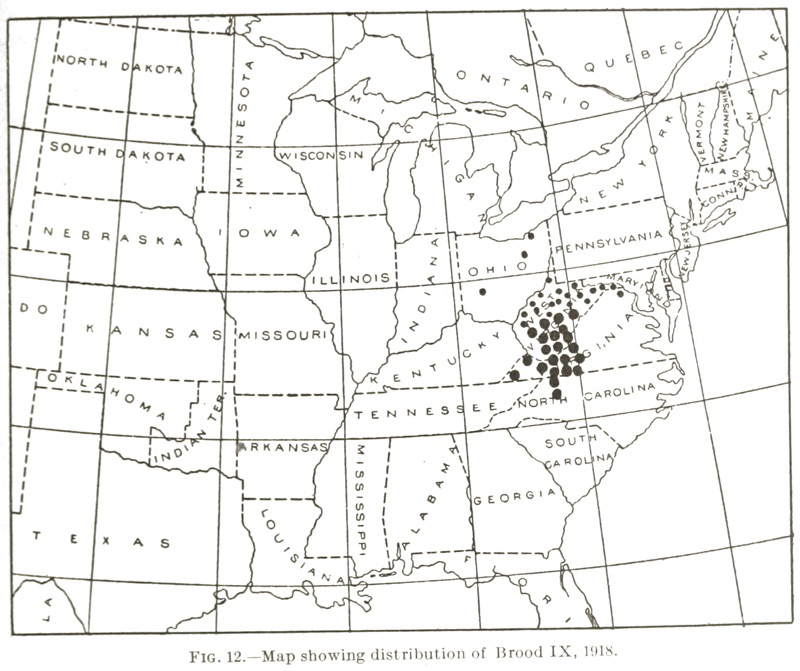
Periodical cicada Brood XIII (13) emerged in the spring of 2024 in Iowa, Wisconsin, Illinois, Indiana, and Michigan (in one or two places). Brood XIII: rotten, but not forgotten. See you in 2041 (Yikes). Relive the memories: Gene Kritsky released a new book. See what people found iNaturalist: Flagging (Brown Leaves), Brood XIII, Massospora, and Blue and White eyes. Buy a shirt. Yes, Brood XIX also emerged in 2024, they did not overlap, but came close in the Springfield, Illinois area.

What, when, where, and why:
What:
Millions of these:
Videos from 2009:
When: Typically beginning in mid-May and ending in late June. These cicadas will begin to emerge approximately when the soil 8 inches beneath the ground reaches 64 degrees Fahrenheit. A nice, warm rain will often trigger an emergence.
Other tips: these cicadas will emerge after the trees have grown leaves, and, by my own observation, around the same time Iris flowers bloom.
Where:
Check out the iNaturalist live map.
More Location Tips:
Local Events
Lake County Forest Preserve in Illinois: 1) A cicada exhibit opening at the Dunn Museum in Libertyville, IL on April 27th. 2) Cicadas of Lake County on 5/2. 3) Celebrating Cicadas on 5/16. 4) On Sunday, June 9th, they plan to hold CicadaFest at Ryerson Woods. Insects, and of course, cicadas will be featured.
Why: Why do they stay underground for 17 years? The prevailing research suggests they have evolved a long lifecycle allowing them to avoid predators that would sync up with their lifecycle & emergence. Why are there so many?! Research suggests that their huge numbers allow them to overwhelm predators, so enough of them will live on to breed and perpetuate the brood.
More facts and fun:
See a modern map or the Live Map from the Cicada Safari app.
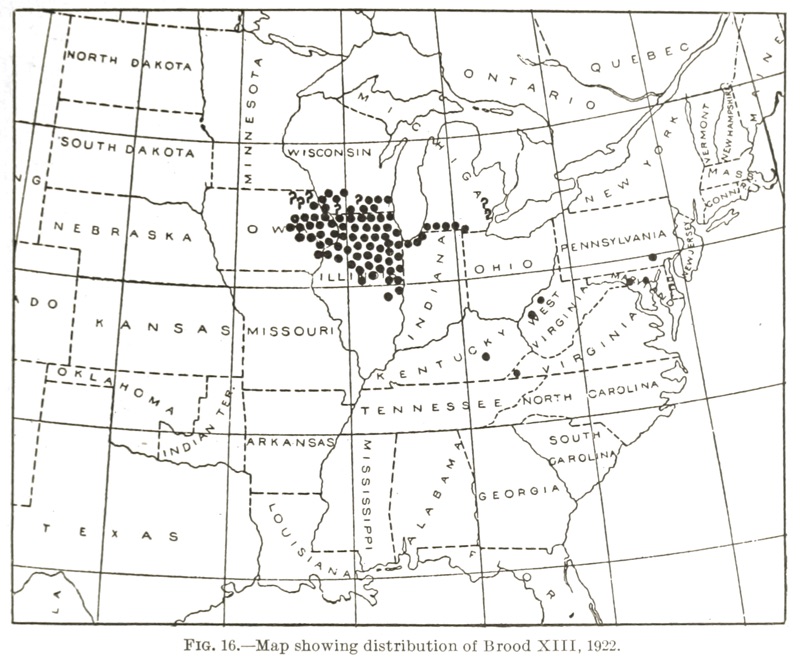
Get the retro 2007 Brood XIII shirt:
Magicicada tredecula Alexander and Moore, 1962
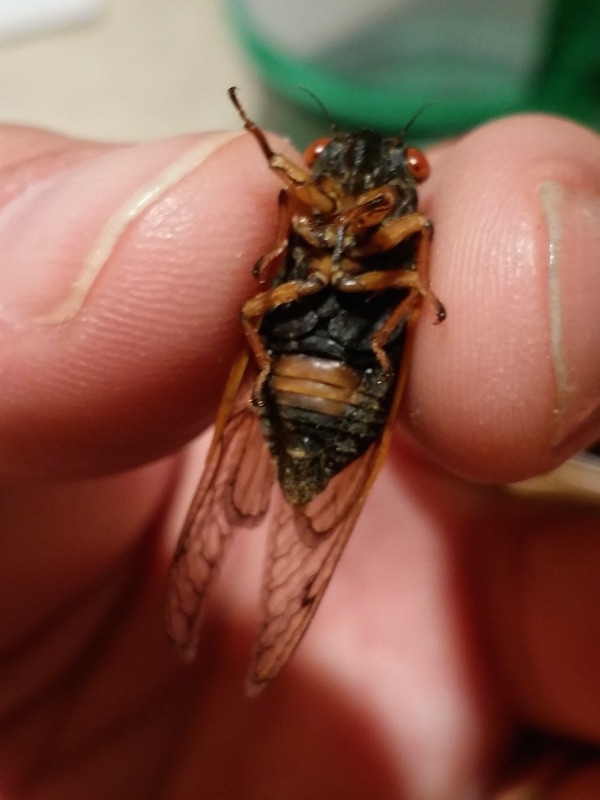
Source: ©Cicada Mania | Species: M. tredecula
Source: Recorded in Ohio, Brood XXII (2013) by Roy Troutman. | Species: M. tredecula
Source: ©Cicada Mania | Species: M. tredecula
Smaller than M. neotredecim & M. tredecim. Orange stripes on its abdomen, through not as much as M. neotredecim & M. tredecim. Its chorus sounds like a ticking clock. Very similar to the 17-year M. septendecula.
Playlists contain multiple videos found on YouTube.
Magicicada tredecula has a 13-year lifecycle.
| Brood | Year | States |
|---|---|---|
| XIX (19) | 1972, 1985, 1998, 2011, 2024 | AL, AR, GA, IL, IN, KY, LA, MO, MS, NC, OK, SC, TN, VA |
| XXII (22) | 1975, 1988, 2001, 2014, 2027 | KY, LA, MS, OH |
| XXIII (23) | 1976, 1989, 2002, 2015, 2028 | AR, IL, IN, KY, LA, MO, MS, TN |
Family: Cicadidae
Subfamily: Cicadettinae
Tribe: Lamotialnini
Subtribe: Tryellina
Genus: Magicicada
Species: Magicicada tredecula Alexander and Moore, 1962
Magicicada tredecim (Walsh and Riley, 1868).
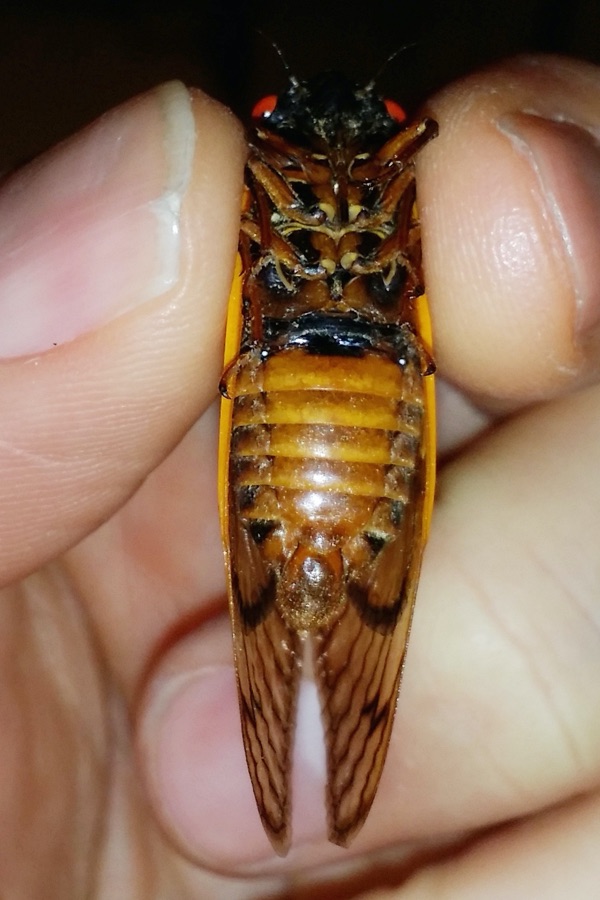
Photo credit: by Dan Mozgai. Ohio.
All Magicicada tredecim information and images on cicadamania.com.
Source: ©Insect Singers | Species: M. tredecim
Similar to M. neotredecim, but the abdomen is typically more orange — these species overlap in limited areas, in which M. tredecim maintains the normal pitch of its call, and M. neotredecim raises its pitch. Read more on Cicadas @ UCONN (formerly Magicicada.org). Larger than M. tredecassini and M. tredecula.
Magicicada tredecim has a 13-year life cycle.
| Brood | Year | States |
|---|---|---|
| XIX (19) | 1972, 1985, 1998, 2011, 2024 | AL, AR, GA, IL, IN, KY, LA, MO, MS, NC, OK, SC, TN, VA |
| XXII (22) | 1975, 1988, 2001, 2014, 2027 | KY, LA, MS, OH |
| XXIII (23) | 1976, 1989, 2002, 2015, 2028 | AR, IL, IN, KY, LA, MO, MS, TN |
Family: Cicadidae
Subfamily: Cicadettinae
Tribe: Lamotialnini
Subtribe: Tryellina
Genus: Magicicada
Species: Magicicada tredecim (Walsh and Riley, 1868)
Magicicada tredecassini Alexander and Moore, 1962.
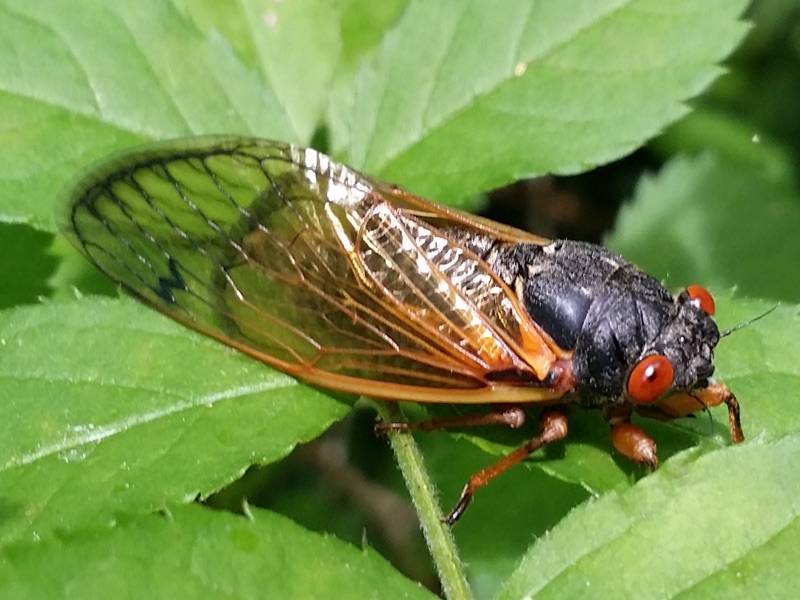
Photo credit: by Dan Mozgai
All Magicicada tredecassini information and images on cicadamania.com.
Source: ©Cicada Mania | Species: M. tredecassini
Its abdomen is black. Its chorus sounds like hissing static. It is smaller than M. neotredecim and M. tredecim. It is very similar to the 17-year M. cassinii species.
Magicicada tredecassini has a 13-Year lifecycle.
| Brood | Year | States |
|---|---|---|
| XIX (19) | 1972, 1985, 1998, 2011, 2024 | AL, AR, GA, IL, IN, KY, LA, MO, MS, NC, OK, SC, TN, VA |
| XXII (22) | 1975, 1988, 2001, 2014, 2027 | KY, LA, MS, OH |
| XXIII (23) | 1976, 1989, 2002, 2015, 2028 | AR, IL, IN, KY, LA, MO, MS, TN |
Family: Cicadidae
SubFamily: Cicadettinae
Tribe: Lamotialnini
Sub-Tribe: Tryellina
Genus: Magicicada
Species: Magicicada tredecassini Alexander and Moore, 1962